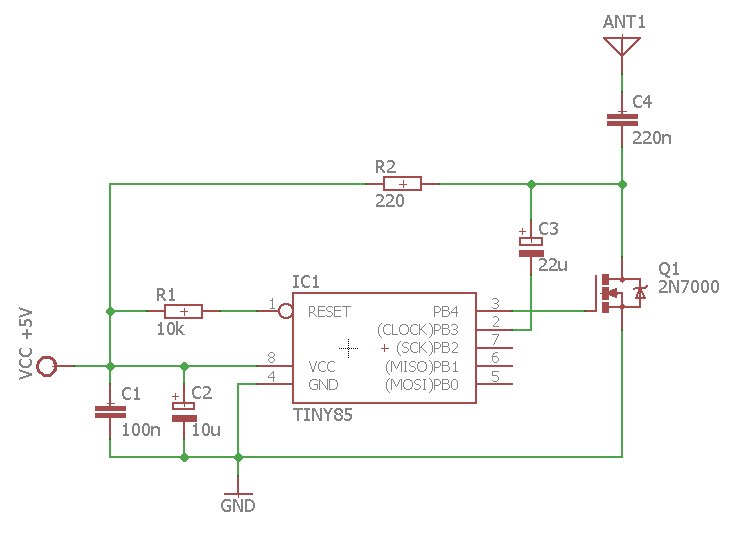AM morse code transmitter with AVR
I wanted to build a simple AM transmitter with only a few meters range, for one geocache where morse code would be transmitted. At first I thought about switching an external "constant-beep" transmitter via AVR but then I stumbled upon a simple schematic that did the whole thing with AVR and only single transistor.
The original source is on this page.
I copied the schematic into EAGLE to make it more visually appealing while making the component values more clear.

It's pretty simple.
AVR runs on internal oscillator at 8 MHz that is divided by 8, so the real frequency is 1 MHz. Clock pulses are output from AVR on PB4 (pin 3). This carrier signal of frequency 1 MHz is modulated by pulses from PB3 (pin 2), which is driven by code. The result is amplified using N-MOSFET and fed into the antenna.
The signal can be tuned on AM band of a regular radio around 1 MHz (not exactly because internal oscillator is not too precise).
Program is simple enough:
#define F_CPU 1000000UL
#include <avr/io.h>
#include <util/delay.h>
#include <avr/interrupt.h>
#define _BV(bit) (1 << (bit)) // _BV macro is not defined so define it here
void beep()
{
for (char i = 100; i; i--)
{
DDRB |= _BV(PB3);_delay_ms(1);
DDRB &= ~_BV(PB3);_delay_ms(1);
}
}
void rest()
{
_delay_ms(200);
}
void dot()
{
beep();
rest();
}
void dash()
{
beep();
beep();
beep();
rest();
}
void space()
{
rest();
rest();
rest();
rest();
}
void spaceWord()
{
space();
space();
}
int main()
{
DDRB |=_BV(PB3);
for (;;)
{
dash(); dash(); space(); // M
dot(); space(); // E
dash(); dot(); dash(); space(); // K
dot(); dash(); dash(); space(); // W
dot(); space(); // E
dash(); dot(); dot(); space(); // B
_delay_ms(1500); // silence
}
return 0;
}When programming, fuses need to be set like this:
- Internal Oscillator 8 MHz
- DIV8 enabled
- CKOUT enabled
Range of the transmitter depends on antenna length. With 10cm wire it was only 1 meter, but with 1,5m wire it covered whole room (which is good enough for me so I didn't try any further). It worked best when I held the antenna in my hand.
The original author used AVR ATTiny44A, I used ATTiny85, which is smaller but still has plenty of usable pins. Also, the transistor should have been 2N7000, but that is an exotic one in Slovakia. I used a different enhancement mode N-MOSFET: FQPF8N60C, and I am pretty sure any other transistor of this type would work.
You can see the result in the following video. I am showing reception on an ordinary radio, also in SDR-Sharp in PC
ZIP file for download contains schematic in PNG and EAGLE format, and source code as an Atmel Studio solution.
